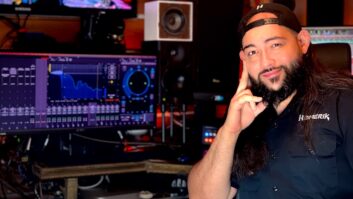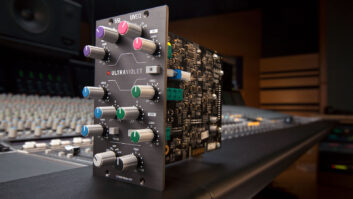Ever since the 1930s, when early experiments in stereo transmission
techniques were conducted on both sides of the Atlantic, two basic but
radically different approaches to stereophonic
recording—coincident microphones vs. spaced
microphones—have coexisted. Each has its own camp of followers
who champion its particular attributes and often denigrate those of the
other.
One of these techniques employs coincident microphones to create a
stereophonic pickup based entirely on the intensity differences
generated between a pair of microphones as the soundwave passes by. Its
claim to fame relies on the strong stability and clear articulation of
the stereophonic image that it creates. Its primary drawback, however,
is a somewhat constricted image width and what some people consider to
be a tendency to sound “dry” or “sterile.” The
other approach uses two (or sometimes three) spaced microphones to
capture and reproduce both the soundwave’s intensity and
time-of-arrival cues as it passes by the microphone array. A natural
result of these time-of-arrival cues is a greater sense of
“spaciousness” than can be achieved with solely
intensity-derived techniques. The drawback, however, is a lack of
articulation across the stereophonic image and what many listeners
consider ambiguity in the center imaging.
Thus, these two camps have staunchly opposed one another: coincident
microphones vs. spaced microphones and articulation vs. spaciousness.
And in the age of multichannel, surround sound production, listeners
demand both an articulate image and spatial envelopment from the
soundtrack. The logical solution, therefore, is to employ techniques
that combine the best attributes of both coincident and spaced
microphones. Choose your compromises wisely.
STARTING WITH THE BASICS: BLUMLEIN AND STEREO
In the early 1930s—when early experiments in spaced-microphone
(left-center-right) stereo were being conducted in the U.S. by the
engineers at Bell Laboratories—British scientist Alan Blumlein,
working for EMI on the other side of the Atlantic, was developing the
concepts of coincident microphone techniques. His pioneering work was
codified in a patent that was issued in 1933, in which he defined and
described a technique to create a stable and articulate stereophonic
image by using just two crossed bidirectional microphones, a
configuration that has come to bear his name: the Blumlein
technique.
Blumlein realized that by using the unique cosine pattern of
bidirectional (figure-8) microphones, the principal pickup axis of one
could be precisely co-aligned with the axis of minimal pickup (the
null-plane) of another, resulting in a very stable, extremely accurate
and well-articulated stereophonic image, one that relies entirely on
the differences in the intensity cues as the sound reaches each of the
two microphones.
In the same patent, Blumlein also described a mathematical
transformation of these crossed bidirectionals, which he termed the
Mid/Side Technique. This also employs a bidirectional
microphone—the Side microphone, which is oriented laterally with
the null-axis aimed directly at the sound source—to provide the
essential directional contribution to the stereophonic imaging. The Mid
microphone provides the overall pickup. Its principal pickup axis is
aimed directly at the sound source; again, co-aligned with the null
axis of the bidirectional microphone. Although not yet a conventional
stereophonic pickup, when the signals of these two microphones are
combined via a sum-and-difference matrix system, left and right
stereophonic signals result: Mid + Side = Left; Mid – Side = Right.
It is important to note that although convention depicts the Mid
microphone as cardioid, it may be any polar pattern, from
omnidirectional to bidirectional. At the same time, the ratio of
Mid-to-Side signals introduced into the matrix can vary. By virtue of
these two variables (Mid-mic polar pattern and Mid-to-Side ratio), an
infinite variety of “virtual stereo pairs” can be created
using this technique.
THE DECCA TREE: A HISTORICAL PERSPECTIVE
Since its inception, the Decca Tree has been widely used for
large-scale recordings and is a favorite among film scoring mixers
because of its ability to maintain excellent imaging and separation
even through the various matrix-encoding systems used to distribute
film soundtracks.
We can trace its origins to March of 1954, when engineers Roy
Wallace and Arthur Haddy at the Decca Studios in London prepared for a
recording session with the Mantovani Orchestra. Always experimenting in
the then-new medium of stereo, Wallace assembled a T-shape steel array
and attached Neumann M49 microphones to each of the three ends. (The
left and right microphones were “hard-assigned” to their
respective channels, and the center mic was assigned equally to the two
channels but at a somewhat lower level to avoid “center
buildup.”) He then suspended the entire array from a large studio
boom, above and slightly behind the conductor’s podium. Wallace
recalls: “It was a crude attempt to re-create the artificial head
that I spent about a year making.” When Haddy first saw the
array, he remarked: “It looks like a bloody Christmas
Tree!” The name stuck.
In later revisions, Wallace and Haddy used Neumann KM56 microphones,
sometimes experimenting with a “Blumlein shuffler” (custom
EQ employed to augment the low-frequency content of the difference
information in a stereo signal). Further refinements by Decca engineers
Ken Wilkinson and Stan Goodall evolved the classic “Decca
Tree” as we know it today: three Neumann M50 omnidirectional
microphones arrayed.
Because the sound arrives at the center of the tree—forward
microphone slightly earlier than the left/right pair—the Law of
the First Wavefront guarantees that this central image will be strongly
focused and clear. This results in a significant improvement over
previous spaced-microphone configurations, which were criticized for
presenting poor or diffused central imaging.
THE BEST OF BOTH WORLDS
A frequent criticism of the coincident Blumlein and Mid/Side pickups is
that their stereo imaging tends to be constricted and lacks the
spaciousness provided by near-coincident or spaced arrays. Conversely,
spaced-microphone techniques are criticized for not providing the same
clear, articulate image that can be obtained with coincident
configurations. An easy and obvious solution to this controversy is to
combine the desirable attributes of both techniques.
Long an advocate of Mid/Side recording, I began experimenting in the
late 1980s with a variation of the Decca Tree that used a M/S
microphone pair—rather than a single omni—as the
front-center pickup. My goal was to maintain the vitality and
articulation from the M/S pickup, while “broadening” it
slightly and providing the spaciousness that could be had only from the
separated, flanking microphones. To preserve the sonic integrity of the
entire array, in my initial experiments, the center-stereo microphone
was an AKG C426 and the flanks were AKG C414s: all large-diaphragm
condensers using the same capsule design. Various spacings were tried,
both front-to-back and side-to-side, which were determined by the size
of the performing ensemble and of the performance space. I created
configurations that ranged in size: from a “mini tree” that
was one meter wide and a half-meter deep, to the
“full-size” tree with the standard spacing of two meters by
one meter.
THE EVOLUTION OF THE “SURROUND SOUND” DECCA
TREE
Building on my experiments with the Decca Tree, I have developed an
expanded surround sound configuration: a Mid/Side microphone—or,
for a more complete surround experience, the SoundField Mk-V
microphone—as the front/center pickup and two pairs of flanking
microphones on the rear bar. One of these pairs is aimed forward
(toward the sound source) and serves to “flank” the
center-stereo pickup in the front left and right channels, as described
above. The second pair is aimed at the rear and provides the essential
signals for the surround channels. This microphone configuration can
combine several discrete stereophonic pairs into a complex and widely
variable complement of conventional frontal stereo and/or surround
pickups.
An important attribute of this array is that all of the microphones
are relatively closely spaced so that minimal phasing anomalies or
cancellations result if/when these signals are mixed down to
“smaller” formats, such as conventional stereo or even
mono. Remember, with all spaced-microphone techniques, phase
cancellations are unavoidable and some comb filtering will inevitably
result. However, due to the relatively close proximity among the
microphones on the Decca Tree, these effects will be less obvious than
with more widely spaced arrays.
For a conventional stereophonic (2-channel) recording, the surround
microphones can be mixed with the other mics’ signals to add ambience
and/or natural reverberation. This will also be reasonably coherent
because it is well within the “fusion zone” of the primary
stereo signals. An ideal choice for these surround microphones is a
pair of hypercardioids with a good off-axis response (such as the
Schoeps MK41 or Neumann AK50 capsules). Because the rear lobes of these
hypercardioids tend to “cross” the channels of the front
stereophonic image (i.e., the left microphone picks up the right side
and vice versa), a “purist” might prefer to use cardioids.
To me, this cross-channel effect actually increases the sense of
envelopment in the total sonic perspective, particularly if the null
angle of each of these surround mics is aimed directly at its opposite;
very much akin to the crossing of the nulls in a conventional Blumlein
pair.
When a SoundField Mk-V microphone system is employed as the
front/center pickup, additional options for surround sound recording
are available, because this unique microphone inherently provides a
surround sound pickup in its own right. With the SoundField SP451
Surround Sound Processor, the system produces a full 5.1 surround array
with complete variability of the balance and sonic perspective. By
combining the SoundField’s coherent surround signals with the 2&3
and 4&5 spaced-microphone pairs, it is possible to create an even
broader spectrum of stereophonic and/or surround sound images, while at
the same time, satisfying the desire for both articulation and accuracy
of the sonic image, as well as breadth and spacious envelopment of the
listener: the best of both worlds.
ASSEMBLING AND USING THE SURROUND TREE ARRAY
It is possible, of course, to configure a surround sound Decca Tree
array by placing (or suspending) each of the microphones individually
in the appropriate relationships to each other. This can, however, be
cumbersome and time-consuming, because it requires five stands or
hanging rigs. A more convenient method is to mount all of the
microphones onto a common Decca Tree fixture and then support the
entire array from above or below as appropriate. Stand-mounting
provides the most ease and flexibility of placement, but the array can
be “flown,” as well.
A SoundField Mk-V serves as the front/center microphone pickup; two
subcardioid microphones are the 2&3 pair; and a pair of
hypercardioid microphones is the 4&5. Of course, any microphones
can be used. Experiment for yourself and have fun. After all,
creativity is the essence of the recording experience.
5.1 AND BEYOND
The basic loudspeaker arrangement for 5.1 surround systems has been
defined as a front pair, a center and a surround pair, plus subwoofer.
Many advocates of surround sound systems, however, urge even more
channels and loudspeakers. Many home-theater systems now offer a 7.1
configuration, adding two loudspeakers directly to the side of the
listener. These additions enhance the sense of envelopment by providing
increased early-lateral (reflection) signals. When the surround sound
Decca Tree employs the SoundField Mk-V microphone as its front/center
pickup, the array can provide sufficient discrete directional
information to generate a 7.1 surround system, because either the
SoundField or the rear-facing microphones (or a combination of both)
can be used to derive the side or surround signals, or vice versa. If
the surround sound Decca Tree is combined with a second pair of
ambience (or additional surround) mics, then the surround depth and/or
the number of channels can be expanded geometrically.
CONCLUSION
Combining the various elements of the surround sound Decca Tree is a
matter of personal and/or professional taste. If a more articulated
image is desired, then the coherent or coincident components should
dominate the mix. To achieve a more “spacious” sound, the
L/R2 and L/R3 pairs may be increased. Additional microphones can also
be added to the mix to highlight individual sections or soloists and/or
to augment the surround experience. Technology, like creativity, knows
no bounds.
The author wishes to thank Roy Wallace, Michael Gray and Tony
Faulkner for their kind correspondences that provided unique personal
insights into the historical background of the Decca Tree
development.







